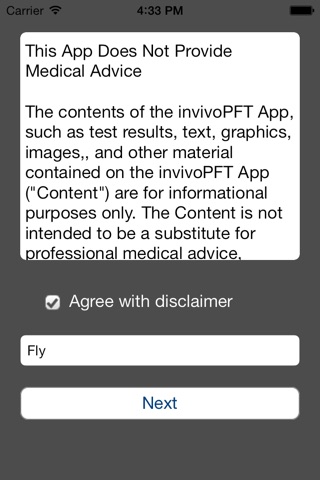
InvivoPFT app for iPhone and iPad
Developer: Jeffrey Klein M.D.
First release : 28 Oct 2014
App size: 21.72 Mb
invivoPFT is a mobile iPhone app that measures Bleeding Area (BA).
Bleeding Area (BA) is defined as the surface area of dried blood spots collected on blotter paper during an Ivy bleeding time (BT) test. Knowing BA, one can determine BV.
Bleeding volume (BV) is defined as the volume of bleeding that occurs during an Ivy BT test.
Ivy Bleeding Time (BT) is defined as the in-vivo platelet function test that measures the duration of bleeding following a standardized superficial incision (e.g. 1mm deep and 5 mm long) on the proximal forearm. As the blood immerges from the incision, it is collected by gently touching the droplet with the edge of a disc of standardized blotter paper. The blotter paper is rotated and reapplied every 30 seconds until the bleeding has stopped. The number of discrete blood spots on the blotter paper divided by two equals the bleeding time in minutes. In order to minimize the confounding effect of variable venous pressure on capillary bleeding time, Andrew C. Ivy suggested placing a sphygmomanometer on the arm inflated to 40mmHg during the BT test. In our experience, the range of normal bleeding times in adults is approximately 2-8 minutes.
Details about the relationship between the Ivy BT test, bleeding area (BA) and bleeding volume (BV) can be found in: Klein JA, vanZandt S, vanZandt J, Zand AN, Klein LEW, Klein PA. Digital photo analysis accurately measures bleeding volume associated with Ivy bleeding time (in preparation). It is shown that BA is a linear function of BV for microliter volumes of blood absorbed onto standardized blotter paper. That is, BA = αBV, where the linear coefficient α is determined by linear regression.
From a clinical perspective, the volume of bleeding is often more relevant than the duration of bleeding. Thus a test that measures bleeding volume has more intuitive appeal than a test that measures bleeding time. invivoPFT provides the first easy and accurate means of measuring BA & BV. It is possible that BA & BV will prove to be a better in-vivo PFT than BT.
BT fell into disfavor in the 1990’s when it was realized that the Ivy BT test has poor sensitivity and poor specificity when used for the purpose of predicting excessive surgical bleeding in an individual patient (sample size n = 1). In part, this is due to the fact that BT has a relatively large intra-patient variance (σ2) . However, the BT test becomes more useful when it is used to compare the effect of a drug on platelet function among a large sample of n subjects (n ≥ 30). In this case the sample-mean BT has a variance of σ2/n.
Suppose we want to study the effect of particular drug on in-vivo platelet function. Let BA0 and BV0 represent measurements based on an Ivy BT test done before the drug delivery. Let BAT and BVT represent measurements based on an Ivy BT test done T hours after the drug delivery. Then δBA = (BAT – BA0)/BA0, is defined as the normalized drug effect on bleeding area. Similarly δBV = (BV24 – BV0)/BV0, is the normalized drug effect on bleeding volume. In an analogous fashion, δBT = (BTT – BT0)/BT0 can be defined the normalized drug effect on Ivy bleeding time.
This “normalization” transformation and the linear relationship A = αV imply that
δBA = (BAT – BA0)/BA0
= (αBVT – αBV0)/αBV0
= α(BVT – BV0)/αBV0
= (BVT – BV0)/BV0 = δBV
In other words, δBA = δBV represents both the proportional change of BA and the proportional change of BV after drug delivery. Furthermore, the α term is unimportant when measuring the drug treatment effect on BV. Statistical tests based on either δBA or δBV are equivalent.



